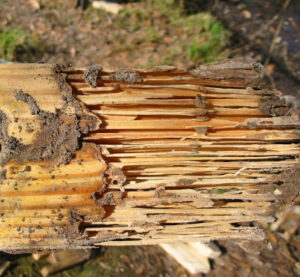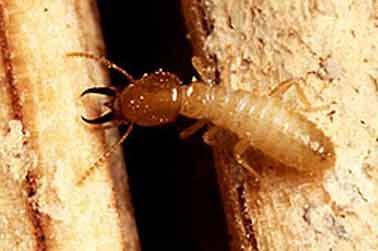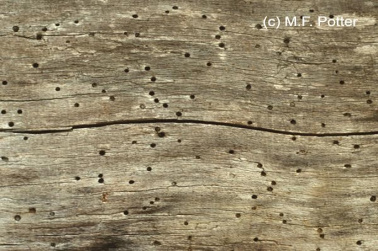Problems with Green Lumber – Part 2: Insects

Insects of Moist Wood
Green lumber refers to lumber that is fresh off the saw and has a high moisture content. In Part 1 we discussed how this sort of lumber is vulnerable to attack by fungi. Now, in Part 2 we will focus on a few of the insects that attack green wood. Pests of moist wood are insects that attack improperly protected lumber and usually attack together with wood-destroying fungi. Some insects attack wood that is partially moist as a result of contact with the ground or becomes wet from faulty construction, improper maintenance or previous insect activity. These insects are usually associated with protozoa, fungi and bacteria that aid them by converting the cellulose and lignin in the wood into materials that are more digestible. Because of these microorganisms, moist and decaying wood provides suitable food and shelter for these insects. Some insects attacking moist wood found in living trees are also usually pests of wood products in contact with the ground or another moisture source.
Termites

Formosan subterranean termite. Courtesy of Dr. Terry Amburgey, Wood Protection Specialists, LLC.
In the southeastern US and along the eastern seaboard, two groups of termites attack wood. Native subterranean termites are the more common. They require wood with a moisture content of more than 20 percent. This group of termites is unique in that they can provide additional moisture to the wood
connecting tubes to wood that is not in contact with the ground. Therefore, if untreated wood is to be placed outside in moist locations, it is imperative that it be placed covered above ground on blocks and not in ground contact. The area around the block should be treated for termite control. Formosan subterranean termites are similar to native subterranean termites but form larger colonies and have more aggressive feeding habits.
Carpenter Ants
Carpenter ants are widely distributed in North America. They are among the largest ants, occurring in lengths of 12 mm or more. They live in a colony in which three castes of adults are recognized: kings, queens and workers. In the US South, carpenter ants readily infest live tulip poplar and black locust trees attacked by the locust borer. The tunnels are often in the grass above the ground. The presence of carpenter ants in residential areas can be serious. They can burrow into wood to make nests, but unlike termites, they do not use wood for food. Also, carpenter ants differ from termites by making galleries that yield complete access across annual rings between the galleries. Trees with butt scars may be weakened by the ants’ galleries and, with time, may be subject to wind throw.
Powder-Post Beetles


Active (left) versus inactive (right) infestations. The former usually have fresh powder accompanying the emergence holes. Courtesy of Dr. Michael F. Potter, University of Kentucky.
The most economically important of the wood-attacking beetles are the powder-post beetles. The anobiid beetles and the lyctid beetles are the two most common powder-post beetles. The anobiid beetles are often called the death-watch beetles because of the tapping sound adults make with their heads as a mating signal. This sound was probably first heard by an individual sitting in a quiet room with a very ill person. These beetles primarily attack sapwood but will also destroy heartwood. They digest the cellulose component of the cell wall at a moisture content of 15 percent and above. Lyctid beetles are also commonly called powder-post beetles and prefer wood that has a moisture content of more than 20 percent or wood that has already been deteriorated by another organism. Lyctid beetles are a serious pest to the sapwood of hardwoods. Lyctid beetles typically start emerging from wood within a year of processing. Thus, infestations usually are encountered in new homes or newly manufactured articles. In almost all cases, infestation results from wood that contained eggs or larvae at the time it was brought into the dwelling.
Wood with large pores such as oak, hickory and ash are most susceptible, but species such as yellow poplar, sweet gum and cherry can also be infested. Most activity occurs with a wood moisture content between 10 percent and 20 percent, but attacks can occur with a wood moisture content of 8-32 percent.
Meet the Author
Dr. Todd Shupe is the President of Wood Science Consulting, LLC. He is a well-recognized expert on wood forensics, wood preservation, wood decay and degradation, and wood species identification. He has a broad background in new product development, quality management, and marketing and sales in both the public and private sectors. For more information please visit DrToddShupe.com.
We welcome your comments below.
Thank you for visiting. We trust that you have enjoyed reading our articles.
Liked this post? Read more below or search for more topics . . .

